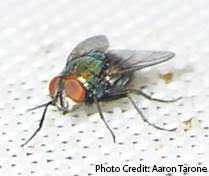By The Texas A&M University System National Laboratories Office
Researchers from the Texas A&M University Department of Entomology and Los Alamos National Laboratory (LANL) are investigating how blow flies could act as environmental monitors for medical, biosecurity, and forensic purposes. This collaboration is made possible by the Texas A&M University System National Laboratories Office and LANL.
Aaron Tarone, Ph.D. and Jeffrey Tomberlin, Ph.D. from Texas A&M, and Migun Shakya, Ph.D., Andrew Bartlow, Ph.D. and Jeanne Fair, Ph.D. from LANL are investigating blow flies and their microbiomes. Their goal is to illuminate how these flies can be used as environmental monitors.

Blow flies feed and can develop on decomposing animals and migrate to other locations either through flight or by “hitchhiking” in vehicles (animals, birds, etc.). They locate dead vertebrates quickly, partly because of their chemosensory capabilities. Since they primarily feed on animal remains, they can act as vectors or carriers for a variety of pathogens.
They make useful environmental samplers since they can be used to monitor vertebrate populations in areas where physical observations would be difficult. This can be accomplished by sequencing DNA and RNA from flies caught in areas of interest. Since they are highly attracted to decaying flesh, which is a source of microbes including pathogens, they could serve as a useful source of information about the sources and ecology of animal diseases.
Blow flies can also be detrimental to livestock, poultry, and surrounding communities by acting as carriers of harmful pathogens. These pathogens may affect animals directly or pass on to humans through meat consumption or contact.
The goal of this project is to collect data about blow flies and their microbiomes in order to expand upon current knowledge and inform future investigations into using blow flies as environmental monitors.
As Tomberlin explained, “Through this collaboration, we are able to explore relationships between organisms associated with decomposing remains historically unattainable, from the smallest (e.g., viruses and other microbes) to some of the largest, flies. By doing so, we can disentangle the complex web of inter-kingdom communication and truly decipher the mechanisms regulating animal behavior.”
